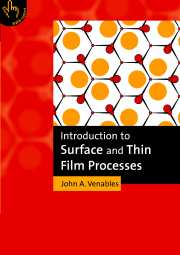Book contents
- Frontmatter
- Contents
- Preface
- Chapter 1 Introduction to surface processes
- Chapter 2 Surfaces in vacuum: ultra-high vacuum techniques and processes
- Chapter 3 Electron-based techniques for examining surface and thin film processes
- Chapter 4 Surface processes in adsorption
- Chapter 5 Surface processes in epitaxial growth
- Chapter 6 Electronic structure and emission processes at metallic surfaces
- Chapter 7 Semiconductor surfaces and interfaces
- Chapter 8 Surface processes in thin film devices
- Chapter 9 Postscript – where do we go from here?
- Appendix A Bibliography
- Appendix B List of acronyms
- Appendix C Units and conversion factors
- Appendix D Resources on the web or CD-ROM
- Appendix E Useful thermodynamic relationships
- Appendix F Conductances and pumping speeds, C and S
- Appendix G Materials for use in ultra-high vacuum
- Appendix H UHV component cleaning procedures
- Appendix J An outline of local density methods
- Appendix K An outline of tight binding models
- References
- Index
Chapter 5 - Surface processes in epitaxial growth
Published online by Cambridge University Press: 06 July 2010
- Frontmatter
- Contents
- Preface
- Chapter 1 Introduction to surface processes
- Chapter 2 Surfaces in vacuum: ultra-high vacuum techniques and processes
- Chapter 3 Electron-based techniques for examining surface and thin film processes
- Chapter 4 Surface processes in adsorption
- Chapter 5 Surface processes in epitaxial growth
- Chapter 6 Electronic structure and emission processes at metallic surfaces
- Chapter 7 Semiconductor surfaces and interfaces
- Chapter 8 Surface processes in thin film devices
- Chapter 9 Postscript – where do we go from here?
- Appendix A Bibliography
- Appendix B List of acronyms
- Appendix C Units and conversion factors
- Appendix D Resources on the web or CD-ROM
- Appendix E Useful thermodynamic relationships
- Appendix F Conductances and pumping speeds, C and S
- Appendix G Materials for use in ultra-high vacuum
- Appendix H UHV component cleaning procedures
- Appendix J An outline of local density methods
- Appendix K An outline of tight binding models
- References
- Index
Summary
This chapter discusses models of nucleation and growth on surfaces, in the context of producing epitaxial thin films. Section 5.1 gives some of the reasons for studying this topic and introduces some ideas needed as background. In section 5.2, we discuss differential equation formulations used to describe nucleation experiments quantitatively, and show how experiment-model comparisons can yield energies for characteristic surface processes. Sections 5.3 and 5.4 describe such comparisons in the case of metals growing on insulators and on metals. Section 5.5 explores steps, ripening and interdiffusion on insulator and metal surfaces. Although many of the same experiments and models are used in studying the growth of semiconductors, the role of surface reconstruction is much more important, so this topic is deferred to chapter 7.
Introduction: growth modes and nucleation barriers
Why are we studying epitaxial growth?
Epitaxial growth is a subject with considerable practical application, most obviously in relation to the production of semiconductor devices, but also to a whole range of other items. For example, magnetic devices such as recording heads have been produced by using metallic multilayers, in which alternating layers of magnetic and nonmagnetic materials produces high sensitivity to magnetic fields; other magnetic examples are bistable switches, where the alignment of the magnetic moments can be parallel or antiparallel in the neighboring layers. Many such films are required to be single crystals with low defect density, and are produced via epitaxial growth processes. The term epitaxy has come to mean the growth of one layer in a particular crystallographic orientation relationship to the underlying, or substrate layer (Schneider & Ruth 1971, Bauer & Poppa 1972, Matthews 1975, Kern et al. 1979).
- Type
- Chapter
- Information
- Introduction to Surface and Thin Film Processes , pp. 144 - 183Publisher: Cambridge University PressPrint publication year: 2000
- 7
- Cited by

